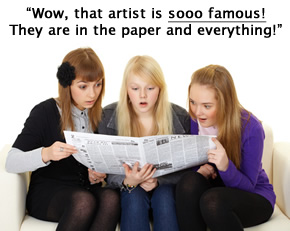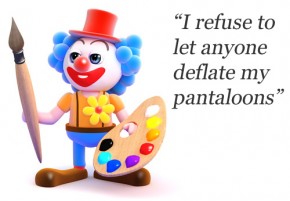Photographing art… For me F-stops and exposure times are alien concepts, however, that does not prevent me from making a relatively decent job of taking snaps of my work to pop on websites, brochures or those snazzy little gallery exhibition cards. I admit it. I’m not much of a photographer. Maybe like me, you concentrate on being a painter, draw-er, printer or whatever-er, and photography in all it’s modern digital mega pixel glory comes fairly low on the list of things that need to be thought about.
Hey, there’s only so many things in life you can concentrate your attention on, and for me photography is not one of them…until I need to take a photograph of an artwork for promotional purposes that is. 🙂
The following tips I’ve picked up myself basically by trial and error, so maybe you can save a bit of time by reading them so you don’t have to go through the same trials and make the same errors! Okay already! On with the tips…
Your camera – big lenses work better
I’m sure actual real photographers will be able to bang on endless about why a camera with a big lens works better than a camera with a little lens, but in my experience of using domestic grade cameras for photographing paintings, the ones that seem to produce the most acceptable results had bigger lens areas. Yup, I’m sorry to disappoint you, but your do-everything-including-wash-the-dishes smart phone has a lens that is just too weeny to cut the art photography mustard, even if it does create images containing enough pixels to reach to the moon and back if they were placed end to end at a distance of one micron.
Tripods steady your trigger finger
Ages ago I picked up a decent quality Velbon Tripod at a garage sale for next to nothing. I’ve used it so many times that things are starting to fall off, yet nevertheless it hangs in there, and gets used over and over again. Even if I’d paid full price, I think the investment would have been well worth it. It just makes the whole process much easier, and more importantly, means that I don’t need to have a steady trigger finger when I shoot. I just set up the shot, lock the tripod adjusty thingies so that they don’t move, and off I go. The good thing about the Velbon is that it’s relatively sturdy and the controls are easy to adjust. When I move the head of the tripod around, everything is smooth as silk. This makes it easy to use. I do have another very cheap tripod too, but that one is not nearly so good…in fact it’s just a pain in the proverbial, and I’ve consigned it to the back of the cupboard, only making an appearance when the Velbon is in need of a little repair. So when it comes to tripods, I’d say get a good sturdy well built one. If you make lots of art you will use it again and again.
Time delay
Read your camera manual to figure out how to set the automatic picture delay timer. This will allow you to delay the taking of your shots by a couple of seconds and avoid your big clumsy fingers causing the camera to shake when it’s mounted on the tripod. Just press the ‘take a picture button’, remove your hands from the camera and let your camera and tripod do their magic. Shake free images are a joy to behold.
Don’t varnish or frame your painting yet!
It’s much easier to photograph and artwork if it’s not varnished yet. Shiny varnish will make for shiny highlights in the photograph, which don’t tend to look good when reproduced.
Similarly, if your artwork is under glass it’s really hard to take a picture without getting reflections. When I’ve been faced with that problem I have solved it by poking my camera through a hole in a large black cloth, held in such a way so that no reflections are seen. It’s a pain though and I don’t recommend it.
My recommendation is to hold off on varnishing or framing until your photography is complete.
Lighting your artwork
I very rarely use any artificial lighting when I take a photograph of my artwork. I prefer instead to use normal daylight. For me I’ve found that a cloudy day is best if I’m taking a photo directly outside. Diffuse cloudy mid-morning light seems the most ideal. Afternoon light is second choice, but the middle of the day starts to be way too bright. I live in Australia though so I rarely get diffuse cloudy days…it’s pretty much blue skies from the get-go in the morning, so instead I tend to take pictures on our covered Verandah where the light is not so harsh, and the reflected light provides enough illumination.
The key to getting the lighting right in my case is to actually LOOK through the view finder (or digital display)…not just a cursory ‘is my image in the middle of the frame’ look, but an actual ‘what is the quality of the light’ look. Sometimes it’s hard to see the quality of the light, but after a few goes at doing this you’ll start to appreciate how the light is falling on your painting, if there are any annoying shadows, and more importantly, whether the image will turn out any good.
Things I look for:
- Is the light even all the way across the image? Any difference in light from one side of the painting to the other will stick out like a sore appendage when you view the image later.
- Can I clearly see all the detail? If the light is too bright all the colours wash out. If the picture is too dark it will lose detail when I try and brighten it up in Photoshop later.
- Does the weave of the canvas show? I create mostly paintings that use almost perfectly flat areas of colour. I generally like my photos to look similarly flat. If you catch the light on your painting on the wrong angle, then the weave of the canvas appears as tiny white highlights all over the photo. Not the effect I want. I move the painting around a bit until the lighting is as even as possible.
- If the painting is textured I check to see that the highlights created by the light are pleasing to the eye.
- Is the painting straight? I like to get the sides of the canvas as straight in the frame as possible. The straighter it is, the less I work I will have to do later when I crop the image. Move your tripod and camera up and down to find the point of maximum straightness (if your paintings are in fact squarish in shape that is) 😉
Take lots of pictures using auto picture mode
I’m very lazy when it comes to setting up my camera. I generally just use the auto mode and rely on the trial and error approach of taking lots of pictures in the hope that one of them turns out to be ‘just right’… and you know what? usually they do (just about every time). When I review the pictures there’s always one version that stands head and shoulders above the rest, so I use it. Digital cameras these days are pretty good at figuring out what to do on my behalf, and I guess there are software engineers out there who have worked hard to program my camera so I don’t really have to think too much about the process. It works for me.
Focus
I also let the camera do all the focussing for me, and generally don’t have any problems when photographing medium sized works as long as I’ve made sure that the artwork is straight in the frame (ie the artwork is a parallel as possible to the camera lens). For larger paintings (say 1.5 metres wide) I do have to consult the manual on ‘multi-point’ focus to make sure everything stays sharp. For smaller works which I have to get very close to I use the macro lens mode, usually indicated by a little tulip on the camera. Mostly though the auto-focus mode does the trick every time.
Turn off the auto flash
A direct flash makes everything look, well, erm…flashed. It’s not nice. So turn it off. Sometimes though you’ll see a dreaded ‘LOW LIGHT’ indicator on your camera viewfinder. Don’t ignore this warning as the camera will not take good pictures if there is not enough light. Move to somewhere else where there is good light (I suggest Australia) 😉
Use Photoshop to fix up your photographs
I use Adobe Photoshop for all manner of things. It’s an essential item in my toolbox. Yes it’s expensive, but if you are doing this stuff on a regular basis it’s the software to have. There are other cheaper programs that do essentially the same job though, but I love my Photoshop and don’t really look at anything else because it works for me.
When I’ve taken my images and look at them on the computer, generally I’ll need to do a few things with them…
- Straighten up the image using the distort tool
- Crop the image
- Adjust the brightness, contrast and colour
- Create versions at different resolutions for web and print distribution
- Tweak anything that needs tweaking to make the picture look as brilliant as possible!
So that’s all there is to it. You can get acceptable results with minimal equipement, at a quality that is fine for web or small postcards using just domestic grade equipment and a bit of experience with Photoshop.
I’m sure if you invest extra time learning the mechanics of photography it would pay you handsomely, and maybe one day I myself will get round to it, but until then I’m just happy to point and shoot.
Having said all that, if you want to create large high quality art prints, posters or giclees it pays to have a professional take the shots for you. I have in the past had professional shots taken using both large format photographic film and super hi-res scanning. The results are far superior, but for most applications the cost can be prohibitive. A decent mid-price domestic digital camera plus a bit of improvisation and experimentation can get you a long way though 😉
Happy Snapping!
[et_bloom_inline optin_id=”optin_3″]












Stuart:
This is really helpful. thanks. do you have your paintings on an easel when you take pix?- how do you get them 100 upright and not leaning slightly backwards?
Robin
I try and get the picture as straight as possible in the frame of the camera…but then photoshop editing, stretching etc takes care of the rest.
I generally use an easel, but it all depends on where I can get the best even light. Sometimes that might be leaning against a fence!
I haven’t taken any photos yet but amabout to! But that is just so helpful and so thorough. Thank you for going to so much trouble to explain it to us.
I lay my paintings on the floor and, using a tripod, point the camera down at the picture. Works ok up to 20″x16″, any larger and I have to improvise.
Hi Stuart,
What kind of camera do you use to shoot you paintings?
Thank you.
Just a $500 fuji camera from the local electronics retailer. Nothing special. Its worth checking on CNET.com for reviews to check which cameras are currently good value for the money you are willing to pay.
Just seen your excellent article. I already do most of what you suggest, except that I use Photoshop Elements. Do you use the full version of Photoshop? I have two main issues: (1) Getting the painting’s colours to be accurate – I use a Panasonic Lumix (2) Getting the horizontal and vertical edges of the painting to have equal horizontal lengths AND equal vertical lengths, with right angles at each of the four corners ie. a perfect oblong. Even by adjusting the tripod, I often find that each vertical edge is not quite identical, and the same for the horizontal edge. Do you stand well back, and zoom in, or do you have another technique to deal with this? Even when I stand back and zoom in, I still experience the problem. I know that I can crop the image, but want to retain as much of the painting in the final image as possible. Any advice?
yes i use full photoshop.
As for colours I’ve just got used to how my screen reacts to colours and how they generally print so I just adjust by best guess, but if you are really picky about exact colour then there are special gizmos the pro designers use for that kind of thing. Its important to note though that just about every screen shows colour differently so you can only make a best guess at what will look good.
For edges I use the distort tool to stretch things into shape. Its best if you get it as straight as possible to start with though.
I generally try and fill the frame without using any zoom.
Thanks for all the advice guys.
Wanted to add that the best way to avoid having to stretch your photos digitally is to make sure that you are shooting the photo straight on, aiming at the exact center of the painting. This is why it’s best to have the painting flat against a wall, as you can easily level many tripods to point straight. This may require buying a semi-decent tripod.
QUICK QUESTION: Any of you folks know how what tool in photoshop is the best for eliminating pixelation? I’m new to photoshop and am having trouble blurring away the pixels without messing up the artist’s beautiful work. Thanks in advance!
-Tyson
As far as I’m aware the only way to avoid pixelation is to have a high resolution in the image itself.
hi guys i am currently doing Btec art for GCSE what will i need to do next im getting a merit and distinction. and how will i be able to earn money.
Thanks people
Amelia
xxx:)
Amelia,
Your question is not specific enough to give you an answer.
Specific questions will result in specific answers 😉
Thank you Stuart for posting this, I am just starting out on a journey of learning on how to photograph my paintings to make prints of them and sell them online.
My paintings are textured quite heavily and I have had challenges with taking photos in my studio. Being in Canada, I am not really able to go outside reliably and was wondering if you could recommend any artificial (interior) lighting that I might use.
I had experience many years ago with film cameras but only my Note 2 (Samsung) phone using digital so far. I am on the market for a digital camera at the moment, would you have any recommendations re: a camera?
Thanks and have a fantastic day!
Anja
I’ve found going outside is best. Just save up the photo session until you have a fine day.
Overcast days can be better than sunny days as you dont get the glare.
Nikon seem to have a good range of Digital SLR cameras these days at good prices.
We just got ourselves a NIKON D3200 and it seems like good value, and probably more than we will ever need for our purposes.
I try to avoid interior lighting if at all possible.
but if you have to use interior lighting I’d suggest checking in on a photography forum for ideas on how to do it properly.
I’ve done interior before but I just used a couple of Halogen floodlights from the Hardware store and reflected them off a white wall to avoid glare. Seemed to work okay… but not as good as outdoors on an overcast day.
I want to take accurate digital photos of my paintings so I can reproduce them as prints. Many of them have a white background, which always comes out grey in the photo. I’ve tried shooting outside, but the grey tone remains. I’ve tried correcting it with Photoshop Elements, but because it’s graded – not a uniform grey – some of it remains. Plus the rest of the painting gets rather over exposed. Is there a solution? Is there a feature on the full edition of Photoshop that will help? I have quite a basic camera – a canon ixus 70 – is that the problem? Thanks for your help.
Full photoshop has tools to enable you to adjust just a certain range of colours. That might help. Check with photoshop specialist sites about selective colour correction tools.
Thanks for that info Stuart, and for your useful article. I’ve also been told that a good way is to have paintings professionally scanned, but that costs rather a lot of money.
Yes to do it properly by a specialist photographer/scanner is very expensive. Years ago I had a full exhibition done that way. $2000 later I had some magnificent quality scans (and lighter pockets)
I am helping a friend take photographers of his large shiny tile mosaics.
The art ranges in size 2′ x 3′ to 3′ x 7′ .
What do you suggest?
Thank you for your help! 🙂
Be careful to avoid direct light when photographing. Try to have indirect ambient light (unless you want to specifically highlight how shiny the tiles are)
Thank you for the tips. I read that an outside on a cloudy day shoot would be best. What are your thoughts?
Also, using a black curtain behind the camera. What about this?
Thanks for your help again. 🙂
Cloudy day..yes. less reflections. Black curtain…also yes.. if the thing you are photographing is shiny.
Really helpful info. Being in Northumberland UK, we have plenty of cloudy days!!